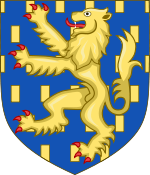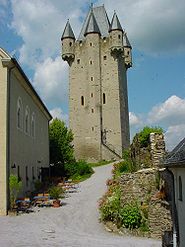- Dudo-Henry, Count of Laurenburg
-
Dudo-Henry of Laurenburg (German: Dudo-Heinrich von Laurenburg) (ca. 1060 – ca. 1123) was Count of Laurenburg in 1093 and is considered the founder of the House of Nassau. The House of Nassau would become an important aristocratic family in Germany, from which are descended the present-day rulers of the Netherlands and Luxembourg.
Contents
Biography
Count Dudo was the son of Robert (German: Ruprecht), the Archbishop of Mainz’s Vogt in Siegerland. It is presumed from their ancestral possessions in the Lipporn area that they were descendants of the Lords of Lipporn, who were mentioned as early as 881 in a document of Prüm Abbey as the owners of parts of the Lipporn-Laurenburg area. Around 950, the Lords of Lipporn obtained the Esterau (the area near present day Holzappel) from Herman I, Duke of Swabia. In 991, a Drutwin from Lipporn is mentioned as Count in the Königssondergau east of Wiesbaden.
Probably with his father, Dudo built the castle of Laurenburg on the edge of the Esterau. This was sometime before 1093, because a "Comes Dudo de Lurenburch" is mentioned in founding charter of the Maria Laach Abbey, in fifth place of the witness list. Some historians, however, have claimed that this document was fabricated. He is later mentioned in a document from 1117 as the Vogt in Siegerland, having succeeded his father. He was a supporter of the Salian emperors, opposing the Archbishops of Mainz, Cologne, and Trier and the Counts of Katzenelnbogen.
Around 1100, Dudo began building Nassau Castle, which would eventually become the home castle of the House of Nassau. This resulted in a century-long dispute with the Bishopric of Worms, which owned the land.
In 1117, Dudo donated land to Schaffhausen Abbey for construction of a monastery in Lipporn. This monastery, built under Dudo's son Robert I in 1126, was the Benedictine Schönau Abbey. From 1141 until her death in 1164, the abbey would be the home of St. Elizabeth of Schönau.
In 1122, Dudo received the castle of Idstein in the Taunus as a fief under the Archbishopric of Mainz. This was part of the inhertance of Count Udalrich of Idstein-Eppstein. He also received the Vogtship of the richly-endowed Benedictine Bleidenstadt Abbey (in present-day Taunusstein).[1]
Descendants
Dudo-Henry of Laurenburg married Anastasia of Arnstein an der Lahn (near present day Obernhof), daughter of Count Louis II of Arnstein (Anastasia, possibly as heiress to Louis II, had claims on the Vogtship of Koblenz). Three children were born of this union:
- Robert (Ruprecht) I, Count of Nassau (1123–1154)
- Arnold I, Count of Laurenburg (1123–1148)
- Demudis, who married Emich, Count of Diez
References
- ^ Die territoriale Entwicklung Nassaus by Ulrich Reuling. Retrieved on 2009-01-20
Sources
- Schwennicke, Detlev (1998) (in German). Europäische Stammtafeln (European Ruler Tables), Neue Folge Band I. Frankfurt am Main: Vittorio Klostermann GmbH. ISBN 3465027434.. Table 60.
- Thiele, Andreas (1994) (in German). Erzählende genealogische Stammtafeln zur europäischen Geschichte, Band I, Teilband 2: Deutsche Kaiser-, Königs-, Herzogs- und Grafenhäuser II (Annotated genealogical tables of rulers from European History, Volume 1, Part 2: German Emperor, King, Duke and Count Houses II) (2nd ed.). Frankfurt am Main: RG Fischer Verlag. ISBN 3895010235.
External links
This article incorporates text translated from the corresponding German Wikipedia and French Wikipedia articles, as of 2009-01-20.
Preceded by
None (founder)Count of Laurenburg
1093–1123Succeeded by
Robert I and
Arnold ICategories:- House of Nassau
- History of Hesse
- History of Rhineland-Palatinate
- 1060 births
- 1123 deaths
Wikimedia Foundation. 2010.


